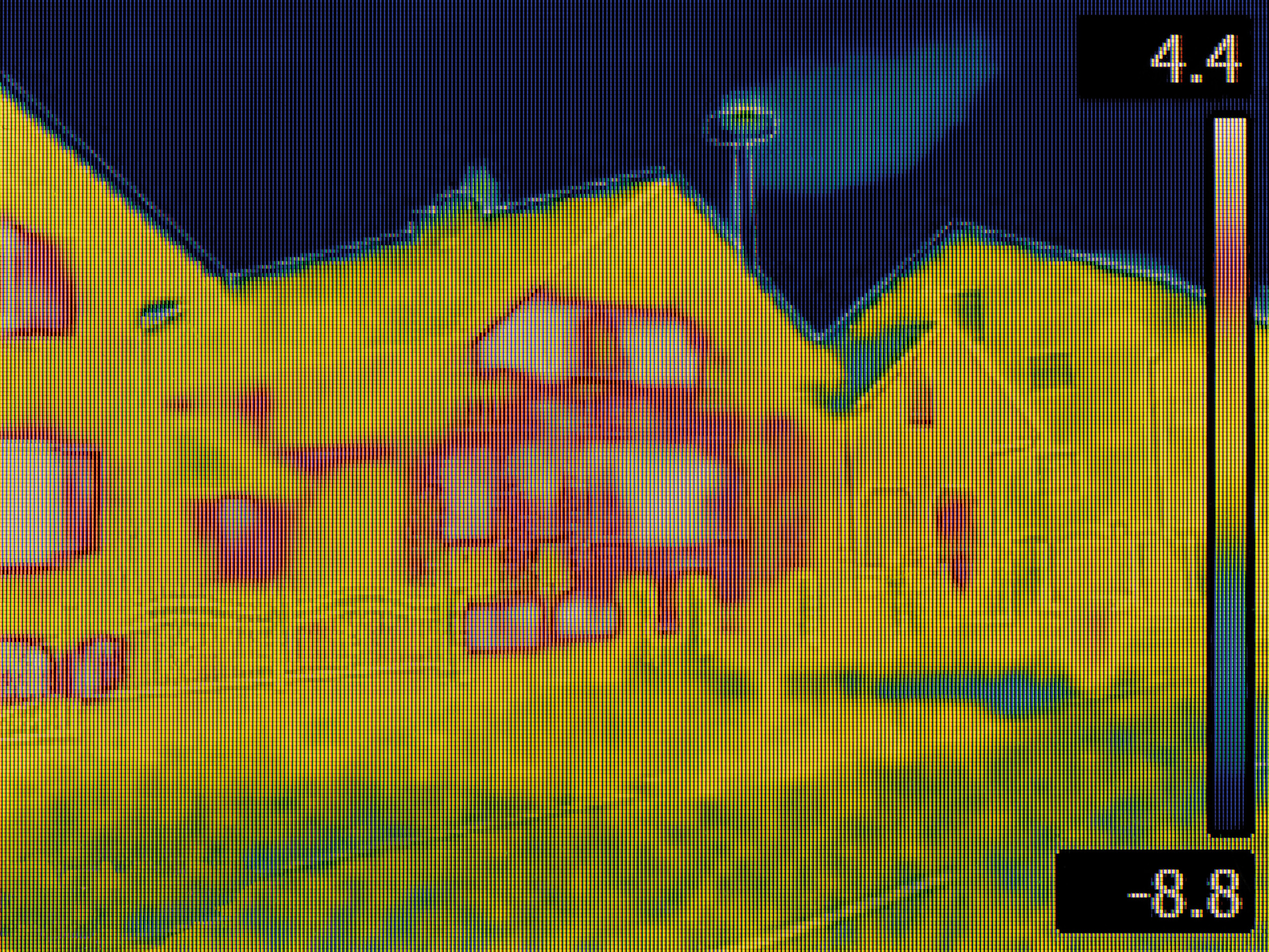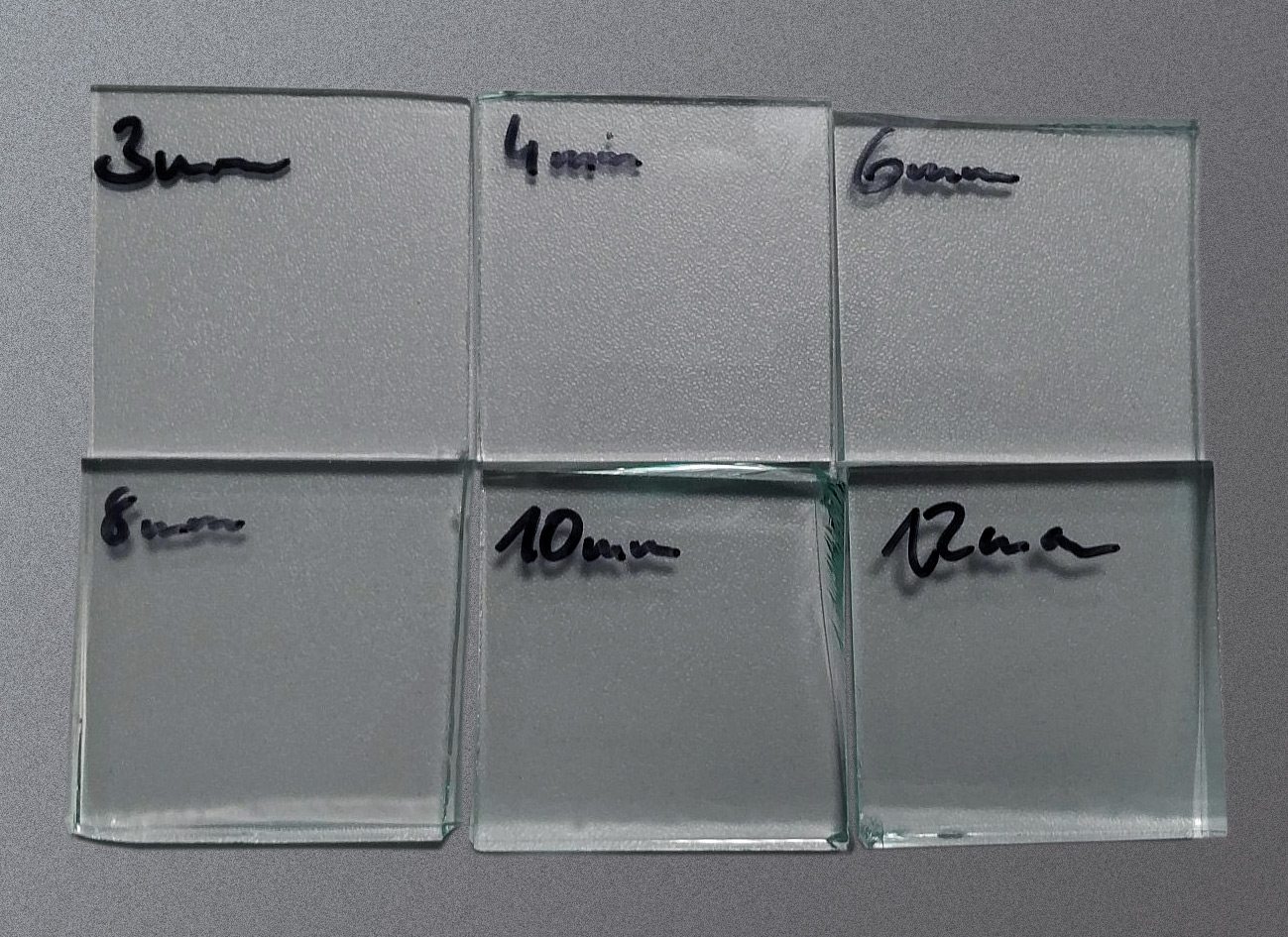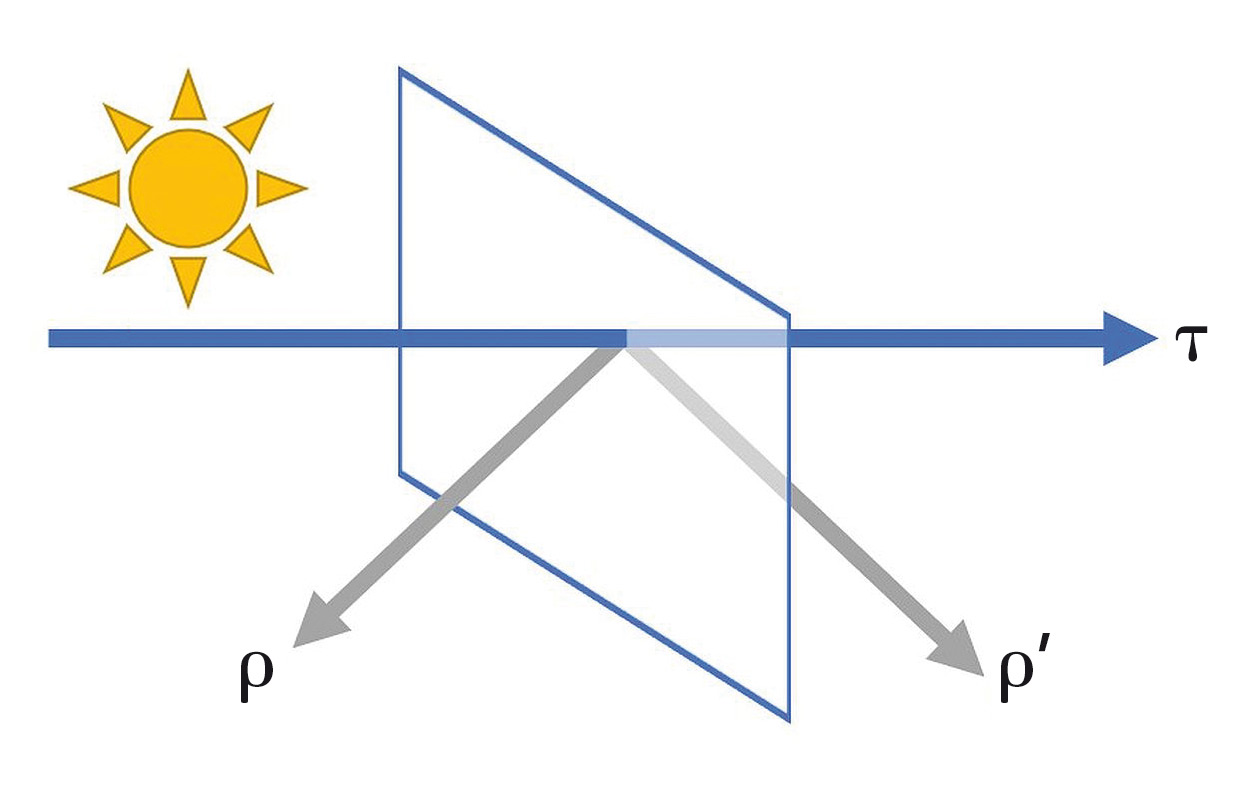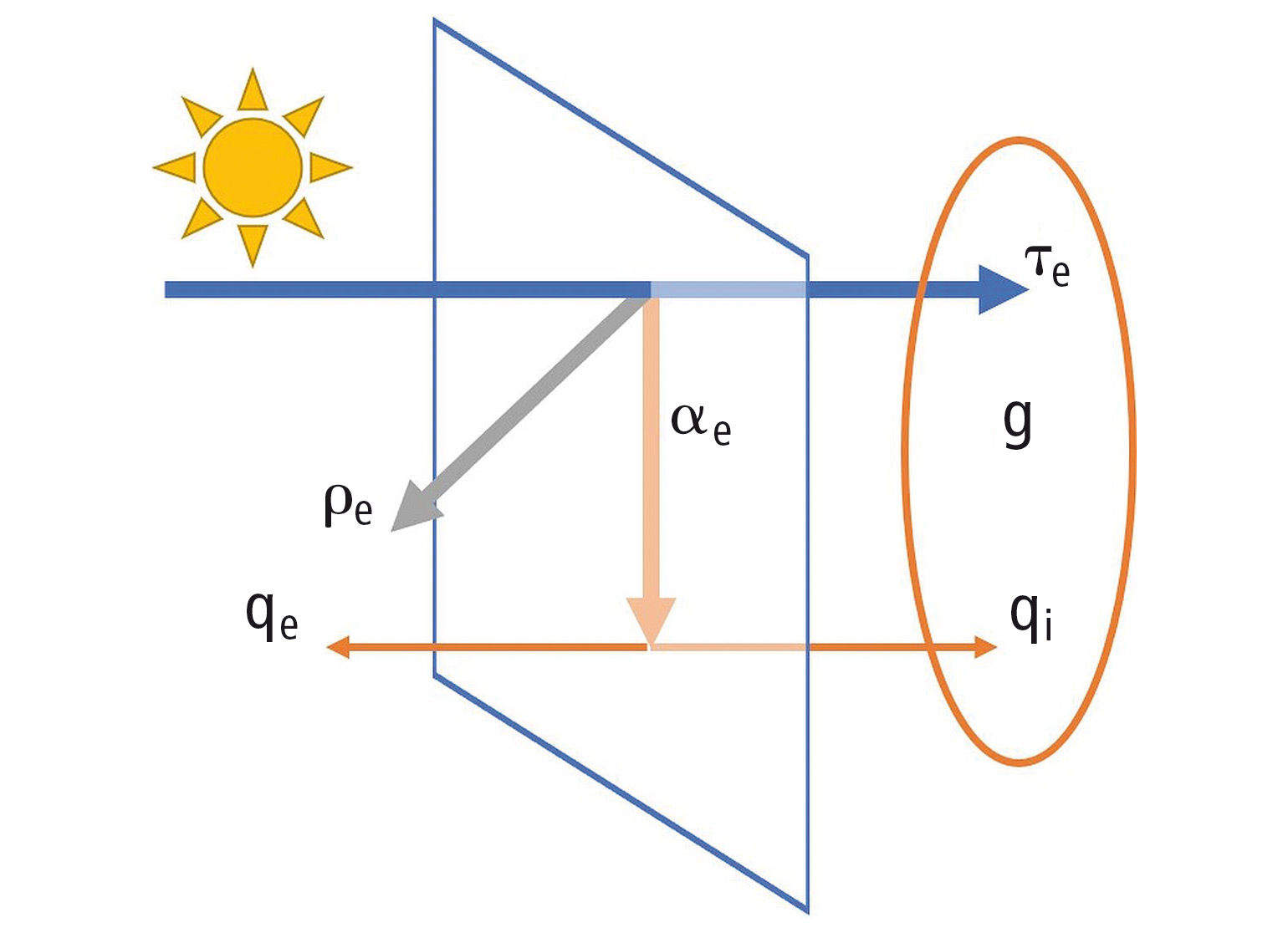Not all glass is the same
Quality control of window glass according to DIN EN 410
 Construction thermography: surfaces with increased heat dissipation are marked in red
Construction thermography: surfaces with increased heat dissipation are marked in red
Windows, glass roofs, conservatories – glass is not only an important building material, but also an architectural element. It shapes surfaces, and modern glasses can even take on static functions. A smartly selected glazing is an important contribution to the effective thermal insulation of a building. It is therefore essential for builders to be able to compare materials based on defined characteristics. For glass and similar building materials, they are defined primarily for the European market in DIN EN 410.
Samples and measurement setup
Shimadzu studied six samples of uncoated soda-lime glass (figure 1) for use in construction. This clear or colored glass can be used both indoors and outdoors. All samples were produced using the float glass process and differ only in their layer thickness. Float glass is the most common type of glass today and is produced in a long, steady flow.
 Figure 1: Examined glass samples. From top left to bottom right: 3, 4, 6, 8, 10 and 12 mm thickness uncoated soda-lime float glass.
Figure 1: Examined glass samples. From top left to bottom right: 3, 4, 6, 8, 10 and 12 mm thickness uncoated soda-lime float glass.
The spectra required to calculate the characteristics were recorded using a Shimadzu UV-3600 Plus spectrophotometer with ISR-1503F integrating sphere. This integration sphere has a diameter of 150 mm and three detectors (photomultiplier, InGaAs, PbS) to cover the entire DIN-compliant measuring range of 300 – 2,500 nm.
The hollow integrating sphere is coated on the inside with a highly reflective material. In the case of the ISR-1503F, Spectralon®, a polymer of fluorine and carbon, is used. Diffused light scattered into the sphere is reflected on the walls until it hits one of the three detectors. For evaluation according to DIN EN 410, the glass sample is measured once in diffuse transmittance mode and once in diffuse reflection mode (8° angle of incidence). The different measurement configurations are shown in figure 2.
 Figure 2: Measurement configurations with the integrating sphere. The diagram shows the side view with the device front facing left. Irradiation with 8° incidence angle also reflects the directionally reflected light on the inner wall of the sphere and not towards the entrance aperture.
Figure 2: Measurement configurations with the integrating sphere. The diagram shows the side view with the device front facing left. Irradiation with 8° incidence angle also reflects the directionally reflected light on the inner wall of the sphere and not towards the entrance aperture.
Definitions of the characteristics
The characteristics defined in DIN EN 410 are referred to in figures 3 and 4. Here, only the calculations for uncoated, single glazing are discussed.
 Figure 3: Photometric characteristics of a single glazing: transmittance τ through the pane, reflectance ρ on the outside and reflectance ρ‘ on the inside.
Figure 3: Photometric characteristics of a single glazing: transmittance τ through the pane, reflectance ρ on the outside and reflectance ρ‘ on the inside.
The starting points for all calculations are measurement of transmittance through the sample and reflectance from each sample side. For coated glass, the transmittance may vary depending on the side, so whichever side of the built-in window is the inside and which is the outside must be defined.
 Figure 4: Radiation-physical characteristics of a single glazing: Direct solar absorptance αe, secondary external heat transfer factor qe, secondary internal heat transfer factor qi and solar factor g as the product of τe and qi.
Figure 4: Radiation-physical characteristics of a single glazing: Direct solar absorptance αe, secondary external heat transfer factor qe, secondary internal heat transfer factor qi and solar factor g as the product of τe and qi.
The characteristics are:
- Spectral transmittance τ(λ) and spectral reflectance ρ(λ) in the wavelength range from 300 nm to 2,500 nm.
- Light transmittance τv and light reflectance ρv for standard illuminant D65. [5]
- Solar direct transmittance τe and solar direct reflectance ρe normalized to the relative spectral distribution of solar radiation. [6]
- Solar factor g.
- UV transmittance τUV normalized to the relative spectral distribution of the UV range of global radiation. [7]
- General color rendering index Ra.
- Shading coefficient SC.
The transmittance and reflectance values (τ[λ], ρ[λ]) measured for individual panes are used to calculate the purely photometric characteristics τv, ρv, τe, ρe and τUV according to equation 1 with tabulated normalization factors.
 Equation 1: Generalized form of the equations describing single glazing with λ as wavelength in nanometers, xi as characteristic, N(λ) as normalization factor and M(λ) as measured value (transmittance or reflectance). The limits of the sum and the scaling factor depend on the respective parameter and are tabulated in DIN EN 410.
Equation 1: Generalized form of the equations describing single glazing with λ as wavelength in nanometers, xi as characteristic, N(λ) as normalization factor and M(λ) as measured value (transmittance or reflectance). The limits of the sum and the scaling factor depend on the respective parameter and are tabulated in DIN EN 410.
In addition, the general color rendering index Ra is calculated from the transmittance spectrum in the visible range and the values for defined test colors tabulated in DIN EN 410. It describes how much the color perception is influenced by the glass.
For multiple glazing, internal reflectance between the panes must be included for all calculations. In this case, the spectra of the panes used are first measured individually. τ(λ) and ρ(λ) are then calculated from these individual spectra for the whole system.
From τe and ρe, further characteristics are determined which are shown in figure 4 and describe the thermal properties of the glazing. The solar direct absorptance αe is the part of the solar radiation that is absorbed by the glass according to equation 2.
 Equation 2: Direct solar absorptance αe with solar direct transmittance τe and solar direct reflectance ρe.
Equation 2: Direct solar absorptance αe with solar direct transmittance τe and solar direct reflectance ρe.
The energy absorbed is converted by the glass into heat and discharged to the inside and to the outside in the form of the secondary external (qe) and internal (qi) heat transfer factor. The calculation of the solar factor g for single glazing with uncoated soda-lime glass can be summarized in equation 3.
 Equation 3: Simplified formula for calculating the solar factor g. For multiple glazing, qi must be calculated using the thermal conductivity of the gas gap.
Equation 3: Simplified formula for calculating the solar factor g. For multiple glazing, qi must be calculated using the thermal conductivity of the gas gap.
For this special case, calculation of the thermal transmittance Ug of the glazing can be summed up as a function of the glass thickness according to equation 4.
 Equation 4: Simplified formula for calculating the thermal transmittance Ug from the glass thickness in meters. In the case of multiple glazing, additional thickness and thermal conductivity of the gas interlayers must be included.
Equation 4: Simplified formula for calculating the thermal transmittance Ug from the glass thickness in meters. In the case of multiple glazing, additional thickness and thermal conductivity of the gas interlayers must be included.
Finally, from g according to equation 5, the shading coefficient SC is calculated. For multiple glazing, the thermal conductivity of the gas gap must be included. The corresponding calculations are given in DIN EN 673. Depending on the material or coating, it may also be necessary to determine the corrected emissivity of each single pane from FTIR spectra according to DIN EN 12898.
 Equation 5: Shading coefficient SC according to DIN EN 410.
Equation 5: Shading coefficient SC according to DIN EN 410.
Measurement results
Transmittance and reflectance spectra of the samples displayed in figure 1 in the range of 300 – 2,500 nm are shown in figure 5. The characteristics calculated from these spectra are given in table 1. For the calculation, a commercial spreadsheet software was used.
 Figure 5: Transmittance spectra (top) and reflectance spectra (bottom) of the six glass samples shown in figure 1 in the spectral range from 300 to 2,500 nm
Figure 5: Transmittance spectra (top) and reflectance spectra (bottom) of the six glass samples shown in figure 1 in the spectral range from 300 to 2,500 nm
As can be seen in table 1, the glass thickness has little effect on the thermal transmittance Ug. Therefore, heat-insulating glazing is achieved by multiple glazing of thin panes (3 – 4 mm) with insulating gas intermediate layers. Additional thermal insulation can be achieved if the outermost pane is provided with a coating which reflects infrared radiation to the outside.
 Table 1: Characteristics of the samples evaluated, as calculated from the transmittance and reflectance spectra shown in figure 5 and the formulae and constants given in DIN EN 410.
Table 1: Characteristics of the samples evaluated, as calculated from the transmittance and reflectance spectra shown in figure 5 and the formulae and constants given in DIN EN 410.
All transmittance and reflectance values of the samples examined here decrease with greater thickness, especially in the UV range. However, the solar direct absorptance and the secondary internal heat transfer factor increase accordingly. Nevertheless, as part of the heat is released to the outside, the overall energy transmittance decreases slightly. With these almost colorless types of glass, the color rendering index is hardly influenced by the glass thickness.
Conclusion
The characteristics defined in DIN EN 410 are important quality features of glazing for different purposes. The material thickness plays only a minor role for the calculated characteristics. To determine the characteristics for the starting material of a glazing, a UV-Vis-NIR spectrophotometer with an integration sphere is required, such as the Shimadzu UV-3600 Plus with ISR-1503. For the assessment of multiple glazing, the properties of the intermediate layers must also be known.
Literature
[1] DIN EN 410:2011, Glass in Building – Determination of Luminous and Solar Characteristics of Glazing, German Version EN 410:2011
[3] DIN EN 673:2011, Glass in building – Determination of thermal transmittance (U value) – Calculation method; German version EN 673:2011
[4] DIN EN 12898:2001-04, Glass in building – Determination of the emissivity; German version EN 12898:2001
[5] CIE No. 15, Colorimetry, 3. Edition (2004)
[6] CIE No. 85, Solar spectral irradiance, technical report (1989)
[7] P. Bener, Approximate values of intensity of natural UV radiation for different amounts of atmospheric ozone, Final Technical Report 1972, Contract No. DAJA 37-68 C-1077